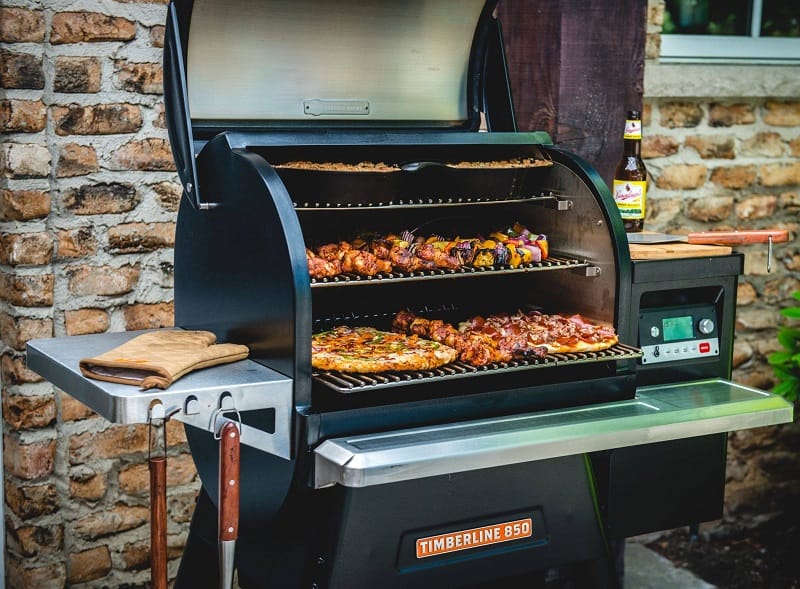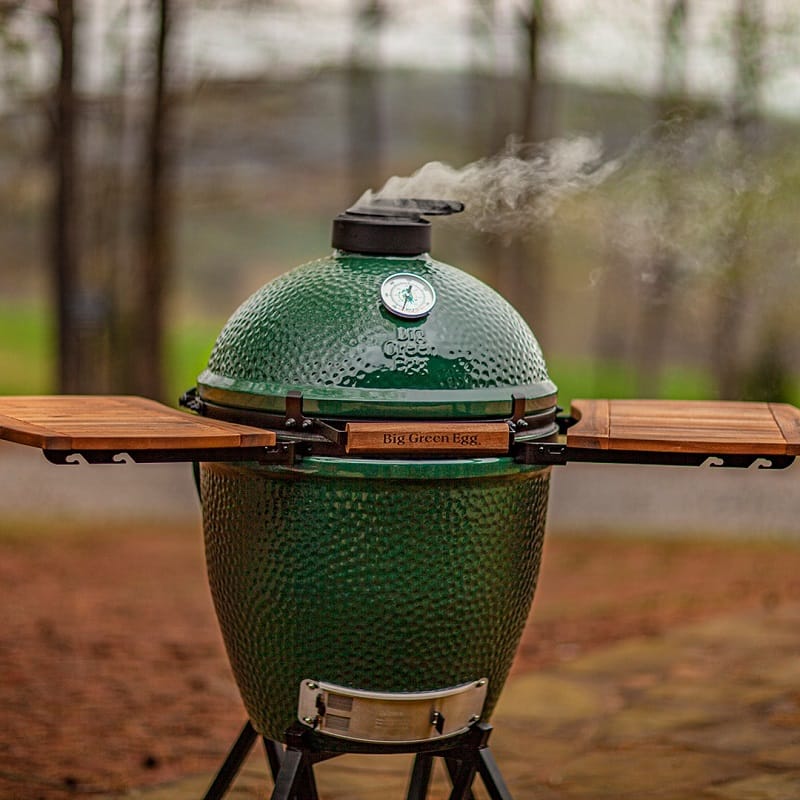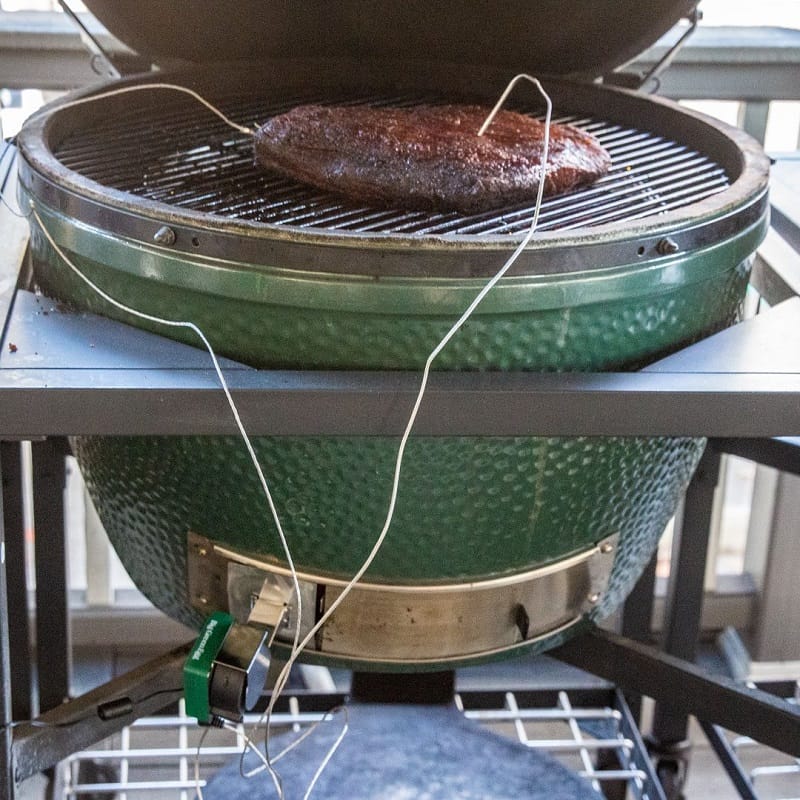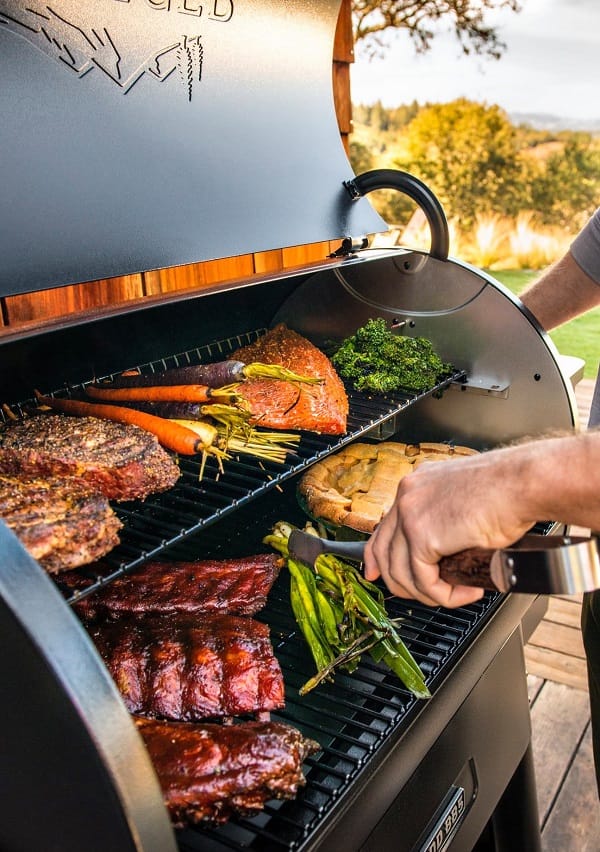Are you looking for the perfect grill to cook up delicious meals? Traeger vs Green Egg is a debate that has been going on for years. Both companies offer great grills with unique features, but which one is right for you? This article will cover the differences between Traeger and Green Egg, their advantages, and, ultimately, which is best for your needs.
About Traeger Grill

As someone who loves to cook outdoors, I’ve used a variety of grills over the years, but the Traeger Grill was unlike anything I had ever used before.
First off, let’s talk about how easy it was to use. The Traeger Grill is a pellet grill that uses wood pellets to heat and cook your food. You must load up the hopper with pellets, turn it on, and set your desired temperature. The grill takes care of the rest, maintaining a consistent temperature throughout cooking. No more constantly adjusting the heat or worrying about flare-ups.
Speaking of cooking, the Traeger Grill produces some of the best food I’ve ever had. The wood pellets give your food a smoky flavor you can’t get with a gas grill. The grill has a large cooking surface so that you can cook up a feast for a crowd. I grilled everything from burgers to chicken to vegetables, and everything turned out perfectly cooked and delicious.
Another great feature of the Traeger Grill is its versatility. You can grill, smoke, bake, roast, and even braise. The grill comes with various accessories, including a temperature probe and a cast iron skillet, to make cooking even easier. The grill has a built-in Wi-Fi controller to control the temperature and monitor your food from your phone.
Overall, I was thoroughly impressed with the Traeger Grill. It’s easy to use, produces delicious food, and is incredibly versatile.
About Green Egg Grill

The Green Egg Grill is one of the most versatile and efficient grills. First things first, the Green Egg Grill is not your typical grill. It’s an egg-shaped ceramic grill used for grilling, smoking, baking, and even roasting. The unique shape of the grill allows for even heat distribution and retention, making it the perfect tool for cooking a wide variety of dishes.
Another great thing about the Green Egg Grill is that it can be used in any weather. The ceramic material is designed to withstand extreme temperatures, from below-freezing to scorching hot. This means you can enjoy grilling your favorite dishes all year round, regardless of the weather outside.
Speaking of favorite dishes, the Green Egg Grill is perfect for cooking everything from burgers to pizzas to slow-cooked meats. The grill’s design allows precise temperature control to achieve the perfect sear on your steak or the ideal smoke flavor on your ribs. And because the grill retains heat, you can cook your food faster and more efficiently than a traditional grill.
But the Green Egg Grill isn’t just a one-trick pony. It also comes with various accessories that make it even more versatile. For example, you can add a baking stone to the grill to create a makeshift oven for baking bread or pizza. Or you can use the grill’s rotisserie attachment to cook a whole chicken or turkey perfectly.
I highly recommend the Green Egg Grill to anyone who loves outdoor cooking. It’s versatile, efficient, and built to last. And with a variety of accessories available, you can customize your grill to suit your specific cooking needs.
Traeger And Green Egg: What’re The Main Similarities

Traeger and Green Egg are two of the most popular grill brands among grilling and smoking enthusiasts. Despite being different in design and purpose, some similarities make them unique and versatile.
One of the main similarities is their use of natural hardwood and charcoal as the primary fuel source, which adds an all-natural flavor to the foods being grilled or smoked. Both Traeger and Green Egg grills offer long and consistent cooking temperatures, allowing for a variety of grilling, smoking, and barbecuing techniques to be applied. They are both made in the USA and have a considerable learning curve for adjusting temperature, requiring some knowledge and skills to achieve perfect cooking results.
Despite their differences, Traeger and Green Egg grills share many commonalities, making them valuable to any backyard or outdoor cooking setup.
What Are The Main Differences Between Traeger Vs Green Egg?

One of the primary differences between the two is their cooking mechanism. The Traeger grill uses wood pellets, while the Big Green Egg uses lump charcoal. Wood pellets provide a smoother smoke flavor and can be customized by selecting different types of hardwoods and fruitwoods. On the other hand, lump charcoal provides a heavier smoke flavor and gives the meat a nice charred finish, providing the perfect crunch.
The Traeger grill also has a high-tech digital temperature control system, while the Big Green Egg has a unique temperature control system using upper and lower vents. Both grills are well-built and designed to last, but the Traeger grill is made from heavy-gauge steel, while the Big Green Egg is made from ceramic. The Traeger grill has a larger cooking surface than the Big Green Egg, making it ideal for cooking larger quantities of food.
Heat Distribution
The Traeger Ironwood is a wood-fired pellet smoker that uses an electric auger and fans to draw pellets into the burn chamber. At the same time, the Big Green Egg XL is a ceramic Kamado-style grill that distributes heat evenly via adjustable airflow. Due to the heat-holding properties of ceramic materials, the Big Green Egg is capable of both extremely low and high temperatures, making it ideal for long periods of low and slow cooking as well as quick, high-heat searing. On the other hand, the Traeger offers precise digital temperature control that allows users to select their preferred cooking temperature easily.
Temperature Control
Regarding temperature control, the Traeger and Green Egg grills have distinct differences. The Big Green Egg grill has a system of upper and lower vents that allow for accurate temperature regulation. However, it can take a while to master this system, and it can be problematic if the temperature gets too hot. The ceramic body of the Green Egg also holds in heat, making it difficult to lower the temperature if it gets too high quickly.
On the other hand, Traeger’s pellet grills use an electronic control panel to moderate the flow of pellets into the fire, allowing for long and consistent cooking temperatures without the need for constant monitoring. This makes the Traeger grill an easier option, but it may not provide the same level of temperature control as the Green Egg.
Read more:
- Griddle Vs Grill
- Pit Boss vs Traeger
- Hickory Vs Mesquite
- Cured vs Uncured Ham
- Cured Vs Uncured
- Types Of Beef Ribs
Grilling Capacity
Traeger grills, which are pellet grills, allow for long and consistent cooking temperatures due to an electronic control panel that helps regulate the flow of pellets. This makes them ideal for those who want to cook for longer periods without constantly monitoring the temperature.
On the other hand, Green Egg grills are Kamado-style grills that require natural hardwood charcoal and have a considerably higher learning curve for adjusting temperature compared to Traeger grills. However, with their excellent heat retention, Green Egg grills are excellent for very long cook times, making them an ideal choice for those who want to smoke their meat for hours.
In summary, Traeger grills are best for those who want a more automated grilling experience, while Green Egg grills are more of a traditional option that requires more knowledge and patience but could result in excellent smoked meat.
Cooking Times
Pellet grills, like Traeger, are known for their efficient cooking times that arise from electronic control panels regulating the flow of pellets into the grill’s fire. This allows for long and consistent cooking temperatures that are easy to maintain. On the other hand, kamado-style grills, such as Green Egg, have a considerably higher learning curve for adjusting temperature but can tease out extremely long cook times from their charcoal.
While both pellet and kamado-style grills offer long, consistent cooking temperatures and are versatile options for many types of grilling, the methods used result in differences in cooking times.
Grilling Temperature
The Big Green Egg features a unique system of controlling temperatures using the upper and lower vents, which can accurately regulate the temperature. However, it can take longer to get the temperature to the desired level, even with the lid off, due to the ceramic’s ability to hold heat.
On the other hand, the Traeger Grill is a wood-fired pellet smoker that utilizes an electronic control panel to moderate the flow of pellets into the grill’s fire, allowing for long and consistent cooking temperatures. Pellet fuel costs are cheaper overall than charcoal, making Traeger grills a more cost-effective option.
Traeger vs Green Egg: Technology

The Traeger grill is a wood-fired pellet smoker with an electric auger and fans. It burns pellets from a feed hopper and offers 885 square inches of cooking space in its Ironwood 885 model. On the other hand, the Green Egg grill is a Kamado-style grill that uses lump charcoal as a fuel source. It has thick, insulated sides made of ceramic and vents that circulate air inside the grill. The XL model offers a cooking surface of 452 square inches. The Traeger grill uses wood pellets to enhance flavors, while lump charcoal burns like briquets without chemicals. Both pellet and lump charcoal use hardwoods like oak, maple, and hickory.
When it comes to temperature modulation, the Green Egg grill has a unique system of controlling temperatures through the upper and lower vents. In contrast, the Traeger grill has advanced technology for remote temperature control. Both grills are well-built and high-quality options, with the Traeger grill made from stainless steel and the Green Egg grill made from ceramic.
Wi-Fi and Bluetooth Connectivity
When it comes to Wi-Fi and Bluetooth connectivity, Traeger grills have the upper hand over Green Egg grills. Traeger’s Pro Series and Ironwood Series come equipped with Wi-Fi technology that allows you to control the temperature and monitor the cooking process remotely through a mobile app. On the other hand, Green Egg grills do not have any form of connectivity and require manual adjustments throughout the cooking process.
This feature can be a game-changer for grillers who want more control over their cooking process or who need to step away from their grill for a bit. Overall, Traeger grills offer a higher level of convenience and technological innovation compared to Green Egg grills.
Grill Accessories
Traeger and Big Green Egg grills have a variety of accessories available to enhance your grilling experience. The Traeger grill offers a wide range of accessories, including cooking utensils, covers, and even a wireless meat thermometer. Traeger also offers wood pellet options like hickory, oak, and apple to add different flavors to your food.
On the other hand, the Big Green Egg grill offers various add-ons such as side tables, nests to elevate the grill, plate setters for indirect cooking, and a convEGGtor to convert the grill into an oven. The Big Green Egg also has various temperature gauges and digital thermometers for precision cooking.
These grills offer unique accessories to make your grilling easier, more enjoyable, and more versatile. It is important to choose accessories that fit with your grill and meet your personal preferences and needs.
The Cooking Process
Traeger grills are pellet grills that use wood pellets as fuel, while Green Egg grills are kamado-style ceramic grills that use lump charcoal. Wood pellets provide a smoother smoke flavor and allow users to choose different combinations of hardwoods and fruitwoods to enhance flavors. On the other hand, lump charcoal gives a heavier smoke flavor and provides a nice charred finish on meats.
In terms of temperature control, Green Egg grills have a unique system using upper and lower vents to regulate temperature. In contrast, Traeger grills have an electric auger and fan system that requires plugging into the work.
Both grills are well-built and have features that cater to specific preferences, so the choice between Traeger vs. Green Egg will ultimately depend on individual needs and cooking style.
The Type Of Meat
Traeger grills use wood-fired pellets as fuel, which provide a smoother smoke flavor. The pellets come in different combinations of hardwoods and fruitwoods, which enhances the flavor of the meat being grilled. On the other hand, Green Egg grills use natural lump charcoal that gives a heavier smoke flavor and a nice charred finish on the meat.
Green Egg grills can hit both shallow and extremely high temperatures than a typical charcoal grill, making them ideal for cooking venison.
Both grills can provide excellent results, but the choice of the grill will depend on the preference of the user and the type of meat being grilled. One must also consider the cooking process, as Traeger grills have a digital temperature control system and rely on electricity. In contrast, Green Egg grills use adjustable airflow to regulate the temperature and do not require electricity.
Size And Portability
Traeger grills are often larger and heavier due to their hi-tech smoking capabilities. For example, the Traeger Ironwood 885 has 885 square inches of cooking space, enough to smoke an entire pig. Additionally, it requires electricity to operate and burns wood pellets from a feed hopper.
On the other hand, Green Egg grills are designed with a ceramic body that enhances heat retention and is much more portable. The XL Green Egg model has a cooking surface of 452 square inches and can be set up anywhere since it’s a charcoal burner. However, at optional costs, it requires a stand, nest, or designated table.
Choosing between the two grills depends on personal preferences, including how much outdoor space is available, how often the grill will be used, and how important portability is when camping or tailgating.
Price
When it comes to price, Traeger grills are generally more expensive than Green Egg grills. The Traeger Ironwood 885, for example, is one of their most advanced smokers and comes with a hefty price tag. On the other hand, Green Egg grills offer a range of options at various price points, with their most expensive model being the XXL Big Green Egg.
While Traeger grills burn wood pellets and are more efficient, the cost per hour for fuel is lower with charcoal used in the Green Egg grill. While Traeger grills may have a higher upfront cost, their fuel efficiency and advanced technology may make them a better long-term investment for serious grilling and smoking enthusiasts.
Are Traeger Grills Easier To Use Than Green Egg Grills?

Both grills offer unique features and benefits. Traeger grills, specifically their pellet grills, offer easy-to-use temperature control without tending to coals. Their electric and fan-powered system also allows for consistent heat and smoke output. However, this convenience does come at the cost of needing to be plugged in and requiring specialty fuel pellets.
On the other hand, Green Egg grills use traditional charcoal and offer excellent heat retention due to their ceramic construction, but require a bit more skill in temperature control and tending to the coals.
Ease of Clean
Traeger smokers have a built-in ash cleanout system that makes cleaning a breeze. The ash cleanout system collects the ashes from the pellets, which can be easily removed from the grill with a vacuum or an ash bin.
In contrast, Green Egg grills have a more traditional cleaning process. The charcoal ashes are collected in the bottom of the grill and must be removed manually. While this may be more time-consuming, it allows for better cleaning process control, ensuring no missed spots.
In summary, Traeger grills are easier to clean due to their ash cleanout system, while Green Egg grills require a more hands-on approach but offer better control over the cleaning process.
Traeger vs Green Egg: The Fuel Efficiency
Traeger grills use wood pellets as fuel, made by pressing wood into pellets without glue. The quality of the wood varies by the manufacturing company. Still, wood pellets offer the advantage of choosing from different combinations of hardwoods and fruitwoods to enhance flavors. Independent testing has found that pellet fuel costs approximately $0.76 per hour to attain 225 degrees for one hour.
In contrast, Green Egg grills use lump charcoal made from hardwoods charred in a smoldering fire to remove wood gases, then snuffed out in an airtight box. Lump charcoal costs approximately $1.50 per hour, making it more expensive than pellets.
While both fuel options offer unique benefits, Traeger grills offer greater fuel efficiency, making them a more cost-effective choice for those who use their grill frequently.
The Warranty
When it comes to grilling, one important factor to consider is the warranty offered by the manufacturer. Traeger offers a three-year warranty on most of their products, while Green Egg only provides a limited lifetime warranty on ceramic parts.
Traeger’s warranty covers any defects in materials or artistry and includes replacement parts, labor, and shipping costs. On the other hand, Green Egg’s warranty only covers the ceramic parts of the grill and only in cases of cracking or breaking.
Additionally, Green Egg’s warranty requires the owner to register the product within 30 days of purchase. Otherwise, the warranty is deemed void.
Design
Traeger grills are pellet grills that use wood pellets as fuel, while Green Egg grills are kamado-style grills that use lump charcoal. Traeger grills typically have larger cooking spaces, such as the Ironwood 885 model, which has 885 square inches of cooking space, while the Big Green Egg XL model has 452 square inches of cooking space.
Traeger grills are made of heavy gauge steel and have a double-wall bottom for efficiency, while Green Egg grills are made of a special ceramic material that is excellent at holding heat. The Traeger grills have an electric auger and fans and require being plugged into the work, while the Green Egg can be set up anywhere and does not require electricity.
Both grills offer options for adding accessories, but the Traeger is typically loaded with various features and has the edge over the competition in design.
What Are The Pros And Cons Of Investing In A Traeger Grill?
Traeger grills have become popular for outdoor cooking enthusiasts, but is investing in one worth it? Here are the major pros and cons of investing in a Traeger grill:
PROS:
- Advanced Technology: Traeger grills are known for their leading-edge technology and ease of use. The Traeger app allows you to control the pellet grill remotely, provides precise temperature control, checks your food status, implements super smoke mode, and receives notifications when it’s time to take your meal off the grill.
- High-Quality Materials: Traeger grills are made of high-quality materials and advanced features, which set them apart from other grilling brands. They are durable and designed to reduce flare-ups while you barbecue.
- Superior Flavor: Traeger grills utilize wood pellets to give your food a deep, smoky flavor. The grill’s design allows you to get the smokey flavor of a wood fire without the actual wood fire.
- Variety of Models: Traeger offers a wide range of models, such as the Traeger Pro, Traeger Ironwood Series, and Traeger Timberline, which have more square inches of cooking surface than much of the competition.
- High-Quality Wood Pellets: Traeger wood pellets are made of natural hardwood with no additives or artificial flavors, providing consistent heat and flavor with every fire.
CONS:
- Expensive Price Tag: Traeger grills are priced at a premium compared to the competition, making them a significant investment in severe grillers.
- Requires Power Source: As an electric grill, Traeger grills require a power source to operate, so you can’t simply throw it in the truck and take it wherever you need a power outlet.
- Longer Cooking Time: This grill takes a little bit more time to cook your food because of the way it operates. You’re also generally cooking at a lower temperature with this grill than with a traditional flame grill.
In conclusion, a Traeger grill offers advanced technology, high-quality materials, superior flavor, a variety of models, and high-quality wood pellets. However, it comes at a higher price tag, requires a power source, and may take longer to cook your food.
What Are The Pros And Cons Of Investing In A Big Green Egg Grill?
Overall, investing in a Big Green Egg grill comes with distinct advantages and drawbacks. Consumers must weigh the pros and cons and make an informed decision based on needs and preferences.
PROS:
- Versatile Cooking: The Big Green Egg can grill, bake, smoke, and roast, making it an excellent investment for outdoor cooking enthusiasts who want a variety of options.
- Durable Material: The Egg is made of thick glazed ceramic that insulates it from the elements, which helps it last for years even with frequent use.
- Heat Retention: Because of its design and build material, the Egg retains heat well, which helps save on time and charcoal when grilling.
- Large Cooking Surface: The Egg comes in seven sizes, with the largest model having a cooking area of 262 square inches, allowing for cooking various food items at once.
- Temperature Control: The Egg includes a built-in temperature gauge and two vents, offering precise temperature control to achieve desired cooking temperatures.
CONS:
- Price: The Big Green Egg grill is quite pricey, making it unaffordable for some consumers looking for a cheaper option.
- Heavy and Bulky: The Egg is quite heavy, with the largest model weighing 162 pounds, making it difficult to move around, especially for tailgating or camping trips.
- Additional Accessories Required: The Egg comes with limited accessories, with essential items like a stand and heat deflector having to be bought separately, adding to the overall cost of the investment.
- Learning Curve: Cooking on an Egg grill requires some expertise, and the complex vent and temperature control system can be overwhelming for novice cooks.
- Limited Availability: The Big Green Egg is not widely available for purchase, with select dealers and stores having exclusive rights to sell the product, making it challenging for consumers to buy it.
How To Maintenance And Cleaning Traeger Grill?
A step-by-step guide to maintaining and cleaning your Traeger Grill
- Vacuum Out Your Grill: Before starting the cleaning process, ensure that the grill is entirely cool. Use a vacuum cleaner or a shop vac to clear out any debris or ash that may have accumulated in the grill.
- Wash Your Grill Grates: If the grill grates are dirty, wash them with warm, soapy water. Use a sponge with a nylon scrub and avoid abrasive materials that can ruin the porcelain coating.
- Remove the Drip Tray: Dispose of any used aluminum foil in the drip tray and line it with fresh heavy-duty aluminum foil. It is essential to cover the drip tray with aluminum foil every time you use the grill to keep it in good condition.
- Take Out The Heat Baffle: The heat baffle covers the hot pot and disperses the flame. Use a shop vac to clean the inside base of the barrel and the small space in the hot pot.
- Use Grease Bucket Liners: Use a grease bucket liner to avoid any grease residue from spilling and contaminating the bucket.
- Put It All Back Together: Put everything back together in the following order- 1) heat baffle, 2) foil-covered drip tray, 3) grill grates, and 4) your lined grease bucket.
How to Maintenance And Cleaning Big Green Egg Grill?
A step-by-step guide to maintaining and cleaning your Big Green Egg Grill
- Begin with a clean burn: Before using the Big Green Egg, do a clean burn to burn any residual fumes from coating or traveling. Fill the grill with lump charcoal and get the hottest burn possible. Open all the vents and remove the vent cap. Let the burn last for an hour before cooling down.
- Use a plastic paint scraper: Wait for the grill to cool, and use a plastic paint scraper to dislodge any stuck-on food or splashes of marinade or juices.
- Remove grates, firebox, and fire rings: After all the burnt gunk is at the bottom of the grill, remove the grates, firebox, and fire rings. Dump the ashes and used charcoal into an ash can. Use a shop vac to remove any remaining ash and charcoal bits from the firebox and rings.
- Clean the grates: Wipe the inside of a cool grill with a soft towel and warm soapy water. Do not use steel scrubbers or brushes, as they can scratch and erode the surface, which can cause flakes that end up in your food.
- Clean the exterior: Use warm water with a drop or two of dish soap to wipe away any debris or grease from the exterior. Rinse with plain warm water.
- Maintain cast iron accessories: To maintain your cast iron accessories, cover your EGG after use once it has cooled down. If your regulator starts looking dull, rub on some Crisco or vegetable oil, such as peanut oil. Perform maintenance on the dual-function metal top once or twice a year. Scrub the inside of the dome occasionally with a wire brush or grit 80 sandpaper.
- Allow the grid to heat up gently: Always allow the grid to heat up gently in your Big Green Egg. Do not place a cold grid in a very hot EGG to prevent any cracks due to sudden extreme changes in temperature. This can be done by placing the grid in the EGG while heating up.
- Tighten nuts and bolts: If you regularly move your Big Green Egg around, nuts and bolts can shake loose, so you should tighten them regularly.
- Store your EGG properly: Always store your EGG immediately after using it if you are not in the mood for cleaning. When you fire it up the next time, clean the grid as soon as it starts heating up.
These steps will keep your Big Green Egg grill in tip-top condition and extend its lifespan. Regular maintenance is important to prevent buildup, maintain the flavor of your food, and avoid voiding your warranty.
What Are The Differences Between A Pellet Grill and Vs Charcoal Grill?

While both grills have advantages and disadvantages, they differ significantly in several areas. For instance, pellet grills use compressed hardwood pellets as fuel, while charcoal grills utilize charcoal briquettes, lump charcoal, or wood chunks, adding a distinct smoky flavor to your meals.
Pellet grills offer great convenience, as they are easy to use and allow you to set a specific temperature consistently throughout the cooking process. Charcoal grills, on the other hand, require a bit more effort to maintain a consistent temperature and require time and practice to master. Pellet grills are more expensive upfront, but charcoal grills can be purchased for less than $200.
Ultimately, deciding which grill to use will depend on individual preferences, the food being cooked, and ease of use. However, pellet and charcoal grills have one thing in common; they can create delicious and flavorful meals with different cooking techniques.
Conclusion
Both the Traeger and the Green Egg are high-quality grills that can deliver delicious results. It comes down to what you are looking for in a grill. If you are a purist who loves the taste of wood-fired food, then the Traeger may be the best option. If you want a versatile grill that can cook various dishes, then the Green Egg may be the way to go.
In conclusion, when it comes to Traeger vs Green Egg, there is no clear winner. Both grills have their strengths and weaknesses, depending on your preference. Whether you choose the Traeger or the Green Egg, you can be sure that you are getting a high-quality grill that will deliver delicious results every time.
References:
- https://www.biggreenegg.eu/en/inspiration/blog-and-events/how-do-i-maintain-my-egg
- https://www.bobvila.com/articles/big-green-egg-review/
- https://support.traeger.com/hc/en-us/articles/4407219978395-Maintaining-Cleaning-Your-Traeger-Grill

Hey readers! Chip Holland here, and I’m a Manager of this website. My passion for writing about it only matches my passion for BBQ. Follow my blog for mouth-watering recipes, tips, and tricks for the perfect smoke, grill, and BBQ. I’m sure you won’t be disappointed!
